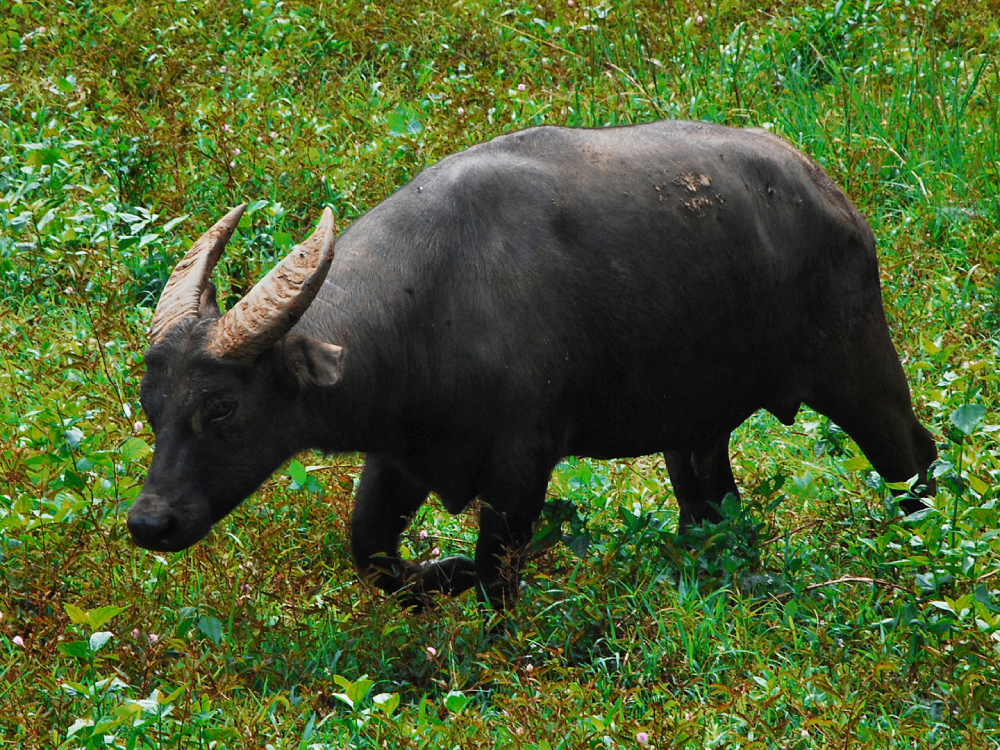The Tamaraw, scientifically known as Bubalus mindorensis, is a critically endangered species of wild water buffalo endemic to the island of Mindoro in the Philippines. Often overshadowed by its more famous relatives, the carabao (domestic water buffalo), the Tamaraw holds a unique place in the biodiversity of the Philippines and stands as a symbol of the country’s natural heritage. Despite its significance, the Tamaraw faces severe threats from habitat loss, hunting, and diseases, prompting urgent conservation efforts.
Physical Characteristics
The Tamaraw is notably smaller than its domestic counterpart, with adults standing approximately 100 to 105 centimeters at the shoulder and weighing between 180 to 300 kilograms. Its compact size is complemented by a robust build, with a dark brown to almost black coat that becomes lighter with age. One of the most distinctive features of the Tamaraw is its set of V-shaped horns, which can grow up to 50 centimeters in length. Unlike the curving horns of the carabao, the Tamaraw’s horns grow straight upwards, giving it a unique and formidable appearance.

Habitat and Distribution
Historically, the Tamaraw was found throughout the island of Mindoro, thriving in its dense forests, grasslands, and riverine environments. Today, its range has been drastically reduced to a few isolated pockets primarily within Mounts Iglit-Baco National Park, Mount Calavite Wildlife Sanctuary, and Aruyan-Malati. The preferred habitat of the Tamaraw includes open grasslands interspersed with forest patches, where they can graze and seek cover from predators and human disturbance.
Behavior and Ecology
Tamaraws are generally solitary animals, a behavior that differentiates them from the more social carabaos. However, they may occasionally be observed in small groups, particularly during mating season or in areas with abundant resources. Their diet mainly consists of grasses, bamboo shoots, and other vegetation found in their habitat. Tamaraws are diurnal, meaning they are most active during the early morning and late afternoon.
Reproduction and Lifespan
The reproductive cycle of the Tamaraw is characterized by a low birth rate, which poses additional challenges for population recovery. Females typically give birth to a single calf after a gestation period of approximately 276 to 315 days. The calf remains with its mother for up to two years before becoming independent. The lifespan of a Tamaraw in the wild is estimated to be around 20 to 25 years, although this can be significantly shorter due to various threats.
Conservation Status and Threats
The International Union for Conservation of Nature (IUCN) lists the Tamaraw as Critically Endangered, with current population estimates ranging from 200 to 400 individuals. The primary threats to the Tamaraw include habitat destruction due to agricultural expansion, logging, and human settlement. Illegal hunting for meat and trophies has also severely impacted their numbers. Additionally, diseases transmitted by domestic livestock pose a significant risk to their health and survival.
Conservation Efforts
Conservation efforts for the Tamaraw have been ongoing, albeit with varying degrees of success. The Tamaraw Conservation Program (TCP), established in 1979, plays a central role in monitoring and protecting the remaining population. Efforts include habitat restoration, anti-poaching patrols, and community education programs to raise awareness about the importance of the Tamaraw. Captive breeding programs, although challenging, have been initiated to help boost population numbers. International collaborations and funding have also been crucial in supporting these conservation activities.
Cultural Significance
The Tamaraw holds significant cultural value for the people of Mindoro and the broader Filipino community. It is considered a national treasure and is featured on the 1980 edition of the Philippine peso coins. The Tamaraw also serves as a symbol of resilience and the need for environmental stewardship. Festivals and educational campaigns often highlight the importance of preserving this unique species for future generations.
Challenges and Future Directions
Despite concerted efforts, the future of the Tamaraw remains uncertain. Effective conservation requires a multifaceted approach, addressing not only the immediate threats but also the underlying socio-economic factors contributing to habitat loss and poaching. Enhanced legal protections, increased funding for conservation programs, and stronger enforcement of existing laws are crucial. Additionally, fostering community involvement and promoting sustainable land-use practices can help mitigate human-wildlife conflicts.
Conclusion
The with its distinct characteristics and critical conservation status, embodies the urgent need to protect and preserve the Philippines’ rich biodiversity. It stands as a reminder of the delicate balance between human development and wildlife conservation. Ensuring the survival of the Tamaraw requires a collective effort, blending scientific research, community engagement, and robust conservation policies. By safeguarding the Tamaraw, the Philippines not only preserves an integral part of its natural heritage but also reinforces its commitment to global biodiversity conservation.









